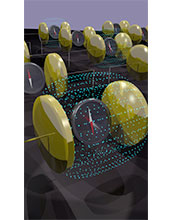Multimedia Gallery
Instant-start computers possible with new breakthrough
A conceptual illustration of the reversal of a magnetization (given by the compasses) with the application electric field (blue) applied across the gold capacitors. The compass needles under the electric field are rotated 180 degrees from those that are not under electric field (zero rotated). Furthermore, a two-step switching sequence is illustrated by the blurred compass needle in the compass under the electric field, making an intermediate state between the zero and 180 degrees rotated states while under the electric field. A team of researchers led by John Heron, a postdoctoral associate at Cornell University, performed this work.
More about this image
Magnetic memories and devices have historically relied on a current of electric charge to generate a magnetic field or the injection of a spin-polarized current to reverse the magnetization of a magnetic layer. These currents are the primary source of power consumption and heating in these devices.
This issue has triggered a new line of research in spintronics: The pursuit of 180 degrees magnetization switching with an applied electric field (i.e., no current flow). Nature has imposed great barriers that complicate such an endeavor; for instance, a compass needle is not sensitive to an electric field but is to a magnetic field. Magnetoelectric multiferroics (materials or heterostructures that possess more than one ferroic parameter with the electric and magnetic orders coupled) enable the electric field control of magnetism. However, the reversal of a magnetization by purely an applied electric field has been elusive due to material symmetry constraints.
In an article published in the Dec. 18, 2014, online issue of Nature, Heron et al. describe a pathway to the reversal of a magnetization with an applied electric field at room temperature using a multiferroic-based heterostructure (Co.90Fe.10/BiFeO3). They propose a mechanism for this switching that relies on the ferroelectric polarization and the canted moment of BiFeO3 switching together under the applied electric field in two sequential steps. The results are then used to demonstrate the electric field control of a traditional spintronic device at room temperature and indicate that the scaled energy consumption is ~ 1 order of magnitude smaller than switching the device with a spin-polarized current.
The research was supported in part by a grant from the National Science Foundation.
To learn more, see the Cornell Chronicle story Multiferroic heroics put instant-on computing in sight.
Or, read Heron's paper "Deterministic switching of ferromagnetism at room temperature using an electric field" in Nature Here. Or see the Nature News and Views story, "Materials science: Two steps for a magnetoelectric switch," Here. (Date of Image: December 2014)
Credit: John Heron
Images and other media in the National Science Foundation Multimedia Gallery are available for use in print and electronic material by NSF employees, members of the media, university staff, teachers and the general public. All media in the gallery are intended for personal, educational and nonprofit/non-commercial use only.
Images credited to the National Science Foundation, a federal agency, are in the public domain. The images were created by employees of the United States Government as part of their official duties or prepared by contractors as "works for hire" for NSF. You may freely use NSF-credited images and, at your discretion, credit NSF with a "Courtesy: National Science Foundation" notation.
Additional information about general usage can be found in Conditions.
Also Available:
Download the high-resolution JPG version of the image. (2.1 MB)
Use your mouse to right-click (Mac users may need to Ctrl-click) the link above and choose the option that will save the file or target to your computer.



